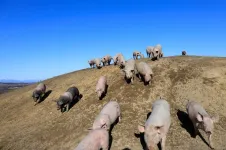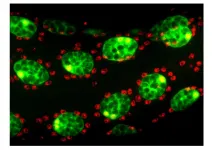The researchers believe the quasars are very close to each other because they reside in the cores of two merging galaxies. The team went on to win the "daily double" by finding yet another quasar pair in another colliding galaxy duo.
A quasar is a brilliant beacon of intense light from the center of a distant galaxy that can outshine the entire galaxy. It is powered by a supermassive black hole voraciously feeding on inflating matter, unleashing a torrent of radiation.
"We estimate that in the distant universe, for every 1,000 quasars, there is one double quasar. So finding these double quasars is like finding a needle in a haystack," said lead researcher Yue Shen of the University of Illinois at Urbana-Champaign.
The discovery of these four quasars offers a new way to probe collisions among galaxies and the merging of supermassive black holes in the early universe, researchers say.
Quasars are scattered all across the sky and were most abundant 10 billion years ago. There were a lot of galaxy mergers back then feeding the black holes. Therefore, astronomers theorize there should have been many dual quasars during that time.
"This truly is the first sample of dual quasars at the peak epoch of galaxy formation with which we can use to probe ideas about how supermassive black holes come together to eventually form a binary," said research team member Nadia Zakamska of Johns Hopkins University in Baltimore, Maryland.
The team's results appeared in the April 1 online issue of the journal Nature Astronomy.
Shen and Zakamska are members of a team that is using Hubble, the European Space Agency's Gaia space observatory, and the Sloan Digital Sky Survey, as well as several ground-based telescopes, to compile a robust census of quasar pairs in the early universe.
The observations are important because a quasar's role in galactic encounters plays a critical part in galaxy formation, the researchers say. As two close galaxies begin to distort each other gravitationally, their interaction funnels material into their respective black holes, igniting their quasars.
Over time, radiation from these high-intensity "light bulbs" launch powerful galactic winds, which sweep out most of the gas from the merging galaxies. Deprived of gas, star formation ceases, and the galaxies evolve into elliptical galaxies.
"Quasars make a profound impact on galaxy formation in the universe," Zakamska said. "Finding dual quasars at this early epoch is important because we can now test our long-standing ideas of how black holes and their host galaxies evolve together."
Astronomers have discovered more than 100 double quasars in merging galaxies so far. However, none of them is as old as the two double quasars in this study.
The Hubble images show that quasars within each pair are only about 10,000 light-years apart. By comparison, our Sun is 26,000 light-years from the supermassive black hole in the center of our galaxy.
The pairs of host galaxies will eventually merge, and then the quasars also will coalesce, resulting in an even more massive, single solitary black hole.
Finding them wasn't easy. Hubble is the only telescope with vision sharp enough to peer back to the early universe and distinguish two close quasars that are so far away from Earth. However, Hubble's sharp resolution alone isn't good enough to find these dual light beacons.
Astronomers first needed to figure out where to point Hubble to study them. The challenge is that the sky is blanketed with a tapestry of ancient quasars that flared to life 10 billion years ago, only a tiny fraction of which are dual. It took an imaginative and innovative technique that required the help of the European Space Agency's Gaia satellite and the ground-based Sloan Digital Sky Survey to compile a group of potential candidates for Hubble to observe.
Located at Apache Point Observatory in New Mexico, the Sloan telescope produces three-dimensional maps of objects throughout the sky. The team pored through the Sloan survey to identify the quasars to study more closely.
The researchers then enlisted the Gaia observatory to help pinpoint potential double-quasar candidates. Gaia measures the positions, distances, and motions of nearby celestial objects very precisely. But the team devised a new, innovative application for Gaia that could be used for exploring the distant universe. They used the observatory's database to search for quasars that mimic the apparent motion of nearby stars. The quasars appear as single objects in the Gaia data. However, Gaia can pick up a subtle, unexpected "jiggle" in the apparent position of some of the quasars it observes.
The quasars aren't moving through space in any measurable way, but instead their jiggle could be evidence of random fluctuations of light as each member of the quasar pair varies in brightness. Quasars flicker in brightness on timescales of days to months, depending on their black hole's feeding schedule.
This alternating brightness between the quasar pair is similar to seeing a railroad crossing signal from a distance. As the lights on both sides of the stationary signal alternately flash, the sign gives the illusion of "jiggling."
When the first four targets were observed with Hubble, its crisp vision revealed that two of the targets are two close pairs of quasars. The researchers said it was a "light bulb moment" that verified their plan of using Sloan, Gaia, and Hubble to hunt for the ancient, elusive double powerhouses.
Team member Xin Liu of the University of Illinois at Urbana-Champaign called the Hubble confirmation a "happy surprise." She has long hunted for double quasars closer to Earth using different techniques with ground-based telescopes. "The new technique can not only discover dual quasars much further away, but it is much more efficient than the methods we've used before," she said.
Their Nature Astronomy article is a "proof of concept that really demonstrates that our targeted search for dual quasars is very efficient," said team member Hsiang-Chih Hwang, a graduate student at Johns Hopkins University and the principal investigator of the Hubble program. "It opens a new direction where we can accumulate a lot more interesting systems to follow up, which astronomers weren't able to do with previous techniques or datasets."
The team also obtained follow-up observations with the National Science Foundation NOIRLab's Gemini telescopes. "Gemini's spatially-resolved spectroscopy can unambiguously reject interlopers due to chance superpositions from unassociated star-quasar systems, where the foreground star is coincidentally aligned with the background quasar," said team member Yu-Ching Chen, a graduate student at the University of Illinois at Urbana-Champaign.
Although the team is convinced of their result, they say there is a slight chance that the Hubble snapshots captured double images of the same quasar, an illusion caused by gravitational lensing. This phenomenon occurs when the gravity of a massive foreground galaxy splits and amplifies the light from the background quasar into two mirror images. However, the researchers think this scenario is highly unlikely because Hubble did not detect any foreground galaxies near the two quasar pairs.
Galactic mergers were more plentiful billions of years ago, but a few are still happening today. One example is NGC 6240, a nearby system of merging galaxies that has two and possibly even three supermassive black holes. An even closer galactic merger will occur in a few billion years when our Milky Way galaxy collides with neighboring Andromeda galaxy. The galactic tussle would likely feed the supermassive black holes in the core of each galaxy, igniting them as quasars.
Future telescopes may offer more insight into these merging systems. NASA's James Webb Space Telescope, an infrared observatory scheduled to launch later this year, will probe the quasars' host galaxies. Webb will show the signatures of galactic mergers, such as the distribution of starlight and the long streamers of gas pulled from the interacting galaxies.
INFORMATION:
The Hubble Space Telescope is a project of international cooperation between NASA and ESA (European Space Agency). NASA's Goddard Space Flight Center in Greenbelt, Maryland, manages the telescope. The Space Telescope Science Institute (STScI) in Baltimore, Maryland, conducts Hubble science operations. STScI is operated for NASA by the Association of Universities for Research in Astronomy in Washington, D.C.
Artist's Illustration: NASA, ESA, and J. Olmsted (STScI)
Science: NASA, ESA, Y. Shen and X. Liu (University of Illinois, Urbana-Champaign), and H.-C. Hwang and N. Zakamska (Johns Hopkins University)
Media Contacts:
Claire Andreoli
NASA's Goddard Space Flight Center, Greenbelt, Maryland
301-286-1940
claire.andreoli@nasa.gov
Donna Weaver / Ray Villard
Space Telescope Science Institute, Baltimore, Maryland
410-338-4493 / 410-338-4514
dweaver@stsci.edu / villard@stsci.edu
Science Contacts:
Yue Shen / Xin Liu
University of Illinois, Urbana-Champaign
shenyue@illinois.edu / xinliuxl@illinois.edu
Hsiang-Chih Hwang / Nadia Zakamska
Johns Hopkins University, Baltimore, Maryland
hchwang@jhu.edu / zakamska@jhu.edu







